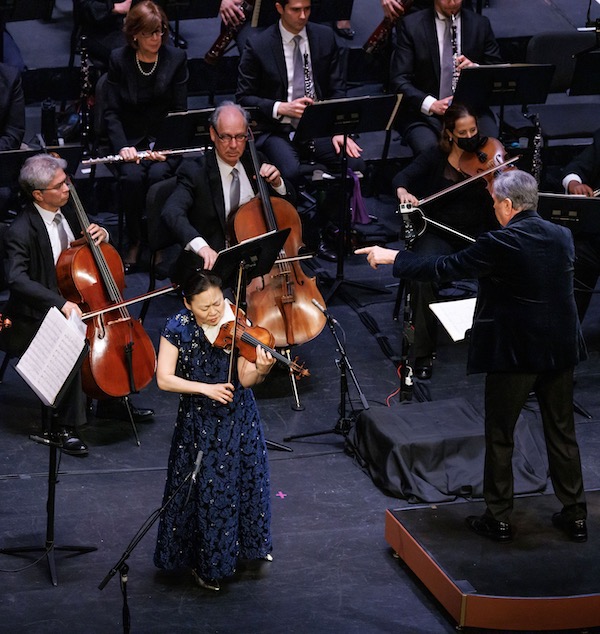Palm Beach Symphony wraps season with vibrant Korngold and Dvořák

Midori performed Korngold’s Violin Concerto with Gerard Schwarz leading the Palm Beach Symphony Sunday at the Kravis Center. Photo: IndieHouse Films
The Violin Concerto of Erich Wolfgang Korngold may not be quite in a position to challenge its more frequently played counterparts by Mendelssohn, Tchaikovsky and the rest.
But the Hollywood film composer’s most famous concert work, premiered in 1947 by Jascha Heifetz, has moved from the fringes of the concerto repertory to a solid position below the top 10 or so. Korngold’s concerto was performed Sunday at the Kravis Center in West Palm Beach by Midori with the Palm Beach Symphony under music director Gerard Schwarz.
The Korngold concerto’s unique sound comes from a combination of soaring, rhapsodic melodies and nervous, rapid passages that growl and crackle—a musical version of the romance and adventure of the movies of Korngold’s era (which he mined for many of the concerto’s themes).
Midori has a huge tone, and through the opening movement and the central Romance, she produced rich sounds in the instrument’s top range, where the concerto spends a lot of time and where other violinists’ tones tend to thin out. She brought real resonance to the double-stops of the cadenza, making them ring through the hall. She appeared to easily handle the work’s technical demands, nailing passages that appeared to call for the instrument to be played as fast as possible.
Some of these fast passages, however, could barely be heard over the orchestra. The concerto is thickly orchestrated, and that creates a challenge for any live performance. But particularly in the last movement, Midori’s virtuosity was more easily seen than heard.
The concert, which wrapped up the Palm Beach Symphony’s 48th season, opened with the American composer William Schuman’s New England Triptych, based on hymns by the 18th century Boston composer William Billings. Despite the work’s roots in the churches of New England, it received its world premiere in 1956 by the University of Miami’s Symphony Orchestra.
Schwarz, a specialist in American music, has recorded all of Schuman’s symphonies, as well as New England Triptych. In the first section, based on the hymn “Be Glad then, America,” the orchestra built a dramatic crescendo from the soft opening notes in the timpani, with edgy string playing and a powerful climax in the brass. Under Schwarz’s baton, the jumpy, strongly marked rhythms came off with taut ensemble precision.
The second section, based on the hymn “When Jesus Wept,” was marked by excellent solo bassoon and oboe playing, grave and serious, with even tones and sensitive phrasing. The final movement, based on Billings’ Revolutionary War song “Chester,” got a rousing and spirited performance marked by fizzing virtuosity in the whirling writing for wind section.
The orchestra sounded best in Dvořák’s Symphony No. 8. The work is imbued with graceful melodies, craggy drama and sweeping grandeur, which the Palm Beach musicians handled with luminous strings, vivacious wind solos and resonant playing from the brass.
Led by the cellos in the opening melody of the Allegro, the strings played with richness and well-balanced tones. The Adagio was marked by drama and bite, particularly with the dark chords produced by the winds.
The Allegretto grazioso opens with one of Dvořák’s most memorable melodies, and the orchestra’s strings and winds played the melancholy dance-like music with style, grace and warmth. The major-theme melody that followed inspired mellow wind playing.
The brassy concluding movement can be a noisy episode, but Schwarz maintained balances so that trumpets, trombones and other brass instrument made their weight felt without overpowering the rest of the orchestra, with the last minutes feeling like the explosion of musical energy intended by the composer.
Posted in Performances
Leave a Comment
Mon Apr 11, 2022
at 2:20 pm
No Comments